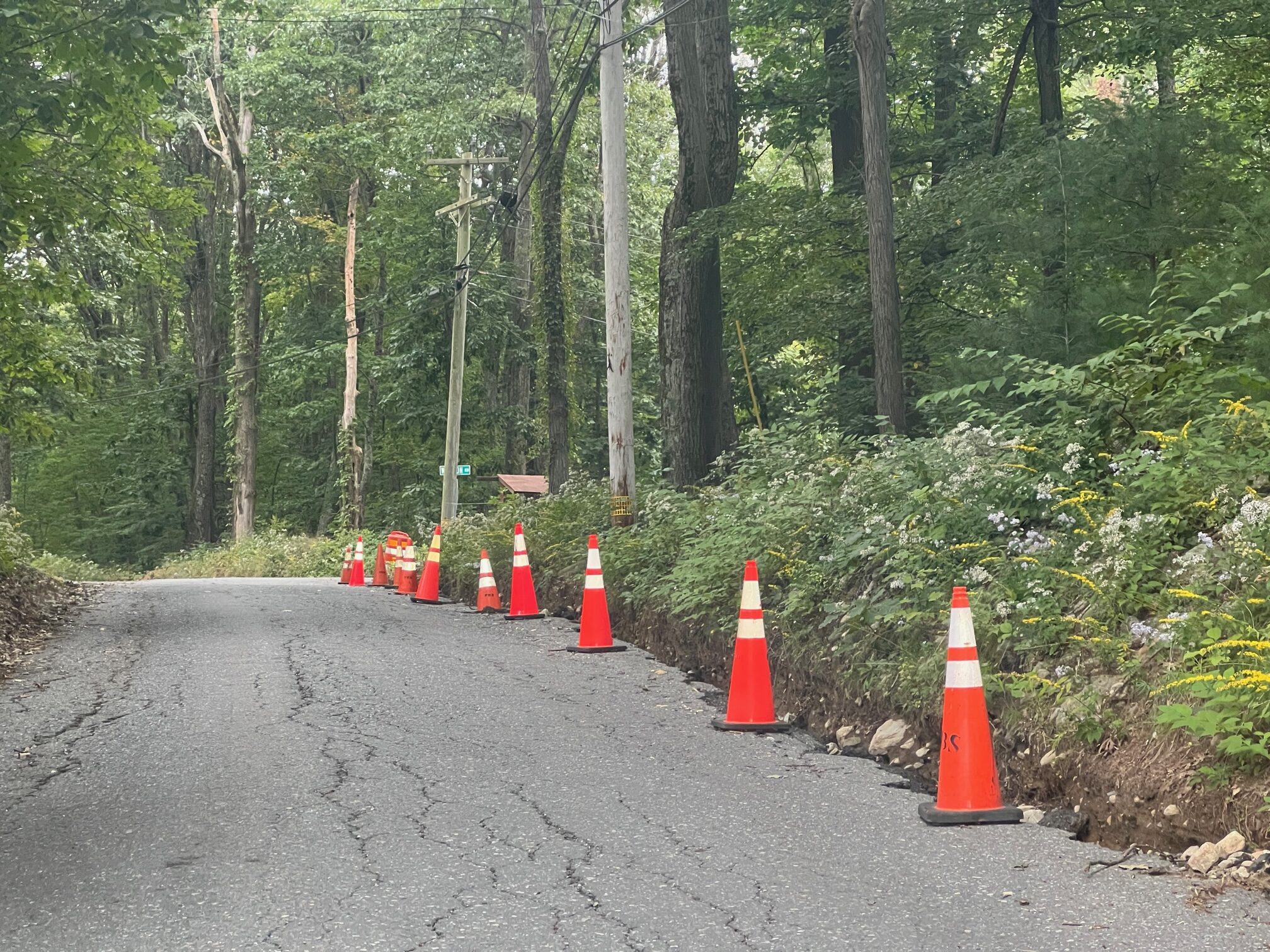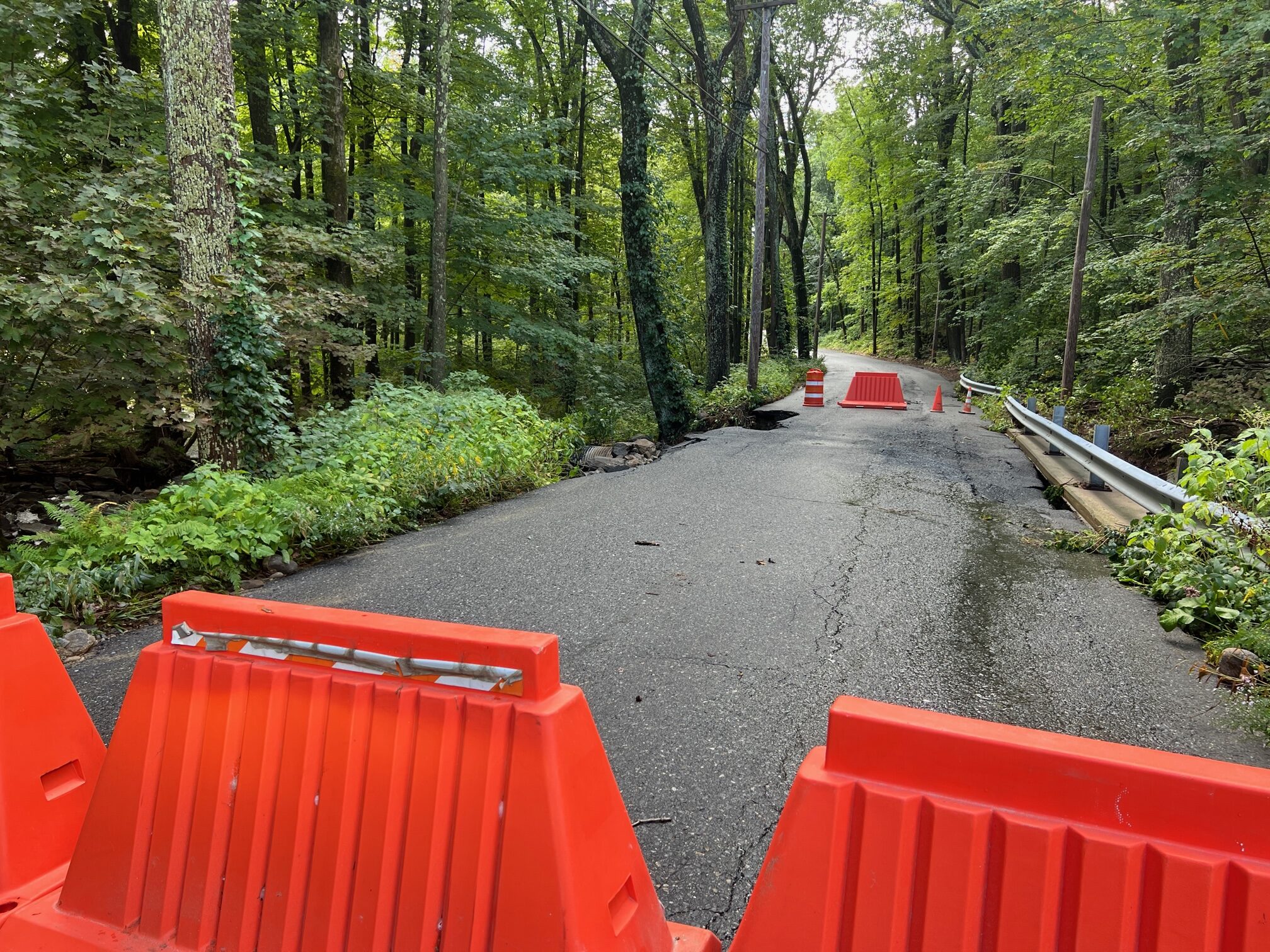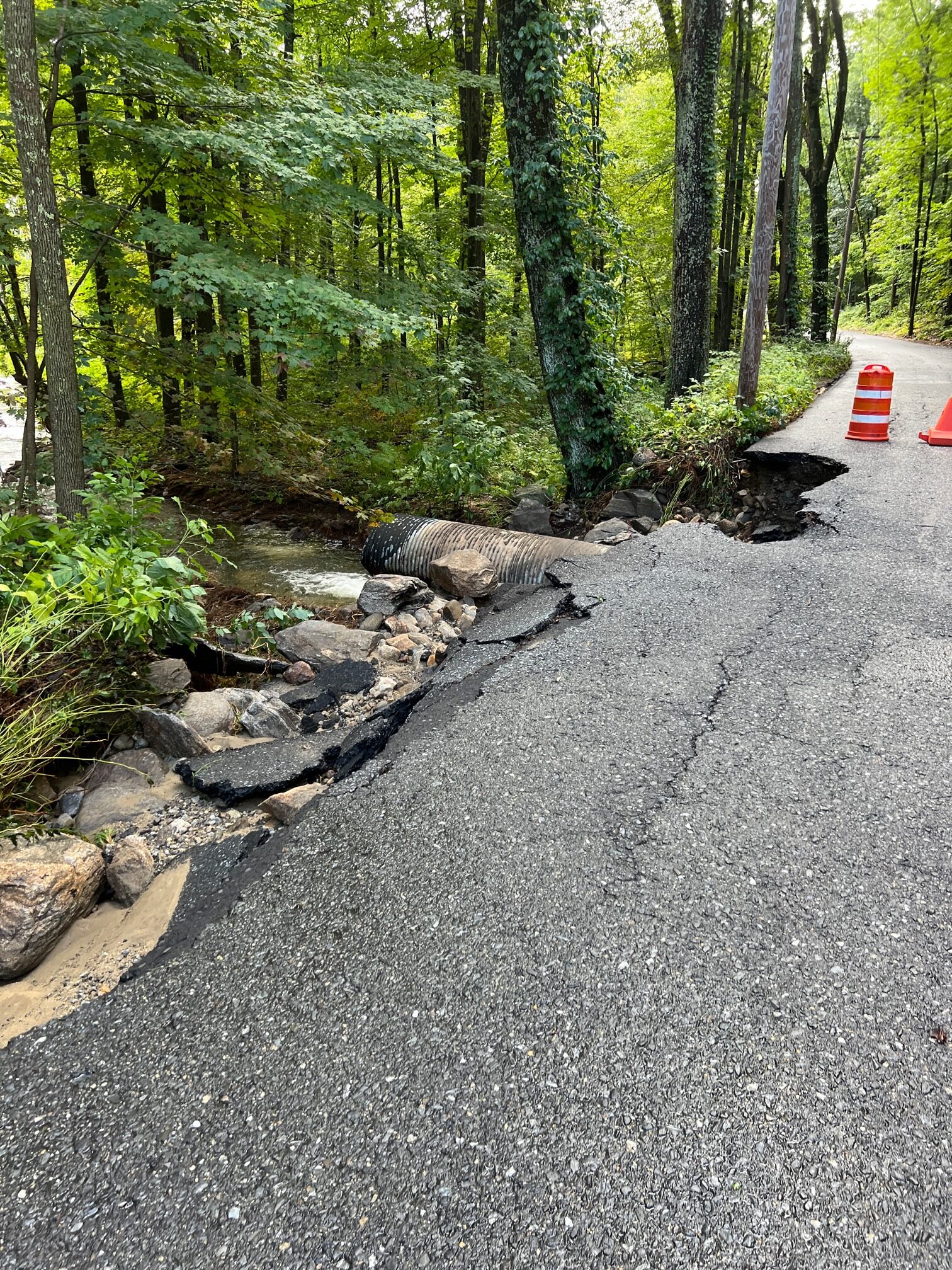
We monitor the weather fairly closely at our house, because among other things (no central A/C but lots of skylights open all summer), it’s been very hard to keep the grass cut this year. It seems like all it does is rain, and then, while waiting for the grass to dry out, it rains again. So, we’ve had a lot of thunderstorm warnings, a tornado warning or two, and continual forecasts for rain. After a while you become immune to the warnings, and that’s what happened to us.
Sure we saw the flash flood warnings, but figured, “Yeah, right. Flash floods in Princeton?–no way. We’re on a mountain, there’s no lakes or big rivers up here, so it just means it’s going to rain some more.” And with that brilliant analysis of the situation, we drove off in Jay’s rather low car to go pick up my car in the shop. Our son Adam told us not to go, because ‘there’s a lot of crazy flooding in Leominster’, but what did he know?

As soon as we headed east on Mirick Road, we noticed that there was more rain and debris on the road than usual during a rainstorm, but nothing severe, so we gave it a glancing thought and kept going.
Everything was fine until we got almost to Beaman Road, and there was a major puddle in the road. I asked Jay if we should drive through it, and he said, “Sure, it should be fine.” It wasn’t, as the puddle turned out to not be a puddle, but to be about nine inches deep and worse, flowing rapidly across the road. By the time we realized that we actually were driving through a minor flash flood, we were in for a penny, in for a pound, so had to keep going. We made it out the other side. “Whew, we thought. We’ll have to go via the main road (Route 140) to get home.”

That thought lasted about two more minutes, until we came upon the much larger flooding coming across the road just before Gregory Road. That definitely was not passable, but now we were stuck between two flash floods in quickly worsening conditions. Now our thoughts weren’t ‘how to get to Gardner’ but rather ‘how to get home’, or more ominously, ‘how to get out of here’.
Luckily we live in the area we were now trapped in, so we know the roads, and realized that we could avoid both known flash flood areas by heading up and over Beaman Road, which very well might have had flash flooding as well, but there wasn’t much choice.
What there were, however, were ‘rapids’ heading down Beaman, which made for the uncanny feeling of being white water rafting in our car. The water was actually flowing considerably faster than we were driving, which kept things interesting.
We were lucky, and didn’t hit any more areas that were impassable, made it to Route 140 (before that was eventually flooded), and headed up Route 31 toward our house. The mess at Krashes Field on Route 31/East Princeton Road hadn’t yet developed, so we made it home fine, unscathed and wiser.

Our Fire Chief John Bennett was interviewed in a story ‘We don’t get flash floods’: Princeton fire chief confronts the unexpected, where he rescued a young driver as her vehicle was being moved sideways by the flow of water–exactly where we had just been. *Apologies if this link takes you to a completely different story. I don’t understand how or why, but the link is being inconsistent.
The next day we went out to see how our little occasional stream, that runs through a wooded area on our property, had made out. It turns out that the little stream, usually dry in a normal year, had turned into a full fledged creek, about forty feet wide, washing all sorts of debris such as pine needles and bridges off to somewhere else.
The ‘bridges’ part is actually pretty amazing. When we bought the house there was a very makeshift bridge, composed of pressure treated lumber, about 12 feet by 2 feet, far in the back corner, which allowed crossing the stream.
The bridge was absolutely gone, but turned up on the other side of Mirick Road, much further downstream, stuck on a tree. How it made that journey of 500+ feet, through a wooded area, and crossed the road is testimony to how high and powerful that flash flood area actually was. I can only imagine what it looked like going across the road.
Mirick Road remained closed for a couple weeks, so we drove the detour over the mountain several times a day. We’ve seen it referenced that there’s $1 Million in repairs to be done on Mirick Road alone. We took this video the day after the flooding.
SHORT VIDEO (too short to embed, apparently) of the worst spot on Mirick Road
This was my first and hopefully last experience with a flash flood. It was Jay’s second, because when he was in 8th grade he lived in Puerto Rico, joined the Boy Scouts, and went on an overnight camping trip, led by troop leaders from North America. They had the young Boy Scouts set up camp near a stream, which later that evening, in heavy rain, turned into a flash flood, resulting in everyone having to abandon their campsites quickly to take shelter on a pavilion about a 1-½ feet off the ground, with no walls, but a roof. No one drowned, but all the tents and sleeping bags, etc. were lost, swept away in the current. He still talks about it on occasion, and this was such an occasion.
Despite our flash flood adventure in Princeton, we’d be remiss to not mention the much more serious flooding in the nearby city of Leominster. We’ve all seen the photos of almost completely submerged cars stranded on Route 2, near the intersection with Route 12. It was almost unbelievable. My first thought was “how did so many cars get stuck in water up to their roof?” I know if I saw a line of 40 or so cars nearly completely underwater, I’d not proceed another inch.
Part of the explanation for this is that the water came up so fast, that people were stuck before they knew what was happening. The entire state of Colorado averages about 17 inches of rain a year. Massachusetts averages more, about 48 inches a year, or about 4 inches a month. Leominster got 10” to 12” of rain, all in one day! Plus, it’s a city, so much of it is paved, which isn’t exactly absorbent, while the surrounding land is hilly. If you annualize the rain amount, Massachusetts would get 3,650 inches of rain a year. No wonder they had such a mess. No one expected it.
The damage was wild too. Besides the many submerged cars on highways and back roads, sinkholes opened up in unexpected places, including a car lot where a number of cars fell into the newly minted sinkhole. At a local mobile home park, populated mainly by the elderly, the residents had to be rescued by boat. Leominster’s entire downtown was flooded. Besides all this, Leominster also experienced the same problems as Princeton–the dirt and rock under paved roads washed away, making them impassable, as well as the sides of roads turning into four foot deep trenches. This was truly a flash flood of epic local proportions.



